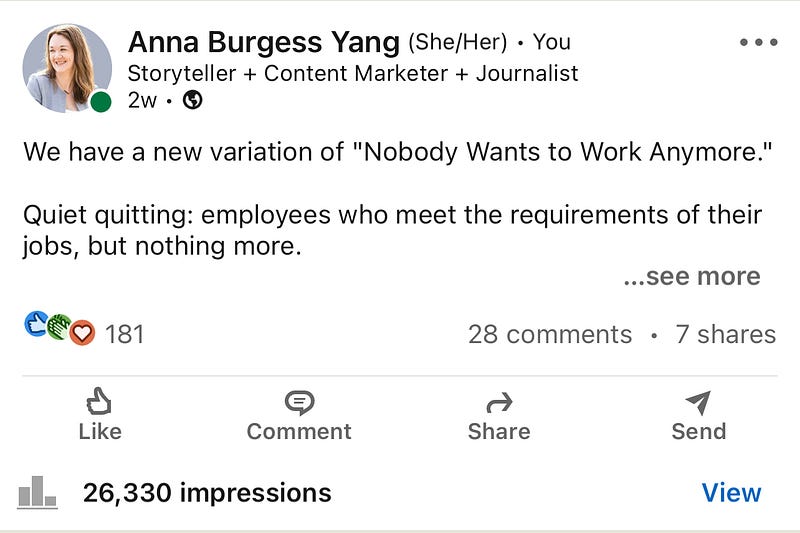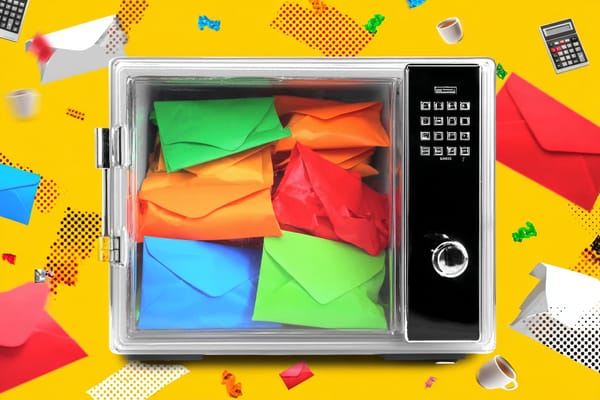The First Time I Went Viral, I Wasn’t Prepared. The Second Time, I Was.
Luck can strike at any time. Will you be ready?

It was an ordinary Thursday morning in August of 2021. I sat down at my computer and wrote my weekly LinkedIn post.
My husband had quit his job over his company’s return-to-office plans. Fully remote work is better for our family, I explained in the post.
What happened next was wild.

The post reached almost 4 million views. It was shared over and over, finally getting featured in LinkedIn’s Talent Blog. I couldn’t keep up with the comments, DMs, and connection requests.
Honestly, it was overwhelming. And almost all-consuming for a few weeks due to the sheer volume.
Writers, freelancers, solopreneurs… we all dream of a viral post. One that gains us recognition and a bunch of new followers. Or maybe even drives new business.
Are you ready if that happens? Because I wasn’t. In hindsight, if I had a few things set up, I would have been better equipped to capitalize on my moment in the sun.
Make sure your profile is in tip-top shape
What’s the next logical step after someone sees your viral post? They head over to your profile.
My LinkedIn profile was fine. But not great. It took about 300 connection requests for me to realize that I should have been in Creator Mode so that people could Follow me without connecting with me.
I’d also been putting off a website redesign. Because my website at the time was embarrassing, I didn’t include a link to it in my LinkedIn profile. Big mistake, since it was a missed opportunity when thousands of people were looking at my profile. (Shortly thereafter, I got my act together and moved my website from Wordpress to Webflow).
Fortunately, I was prepared with a Calendly link. I ended up meeting with several people about freelancing work and speaking on podcasts. The link made it easy to schedule a time.
Your profile should always be ready to let people know who you are, what you do, and how they can contact you. Keep it up-to-date, since you never know when people will be looking.
Be ready to send invoices and accept payments
At the time I went viral, I had a single freelance client. I was sending invoices via a Google Sheet and receiving checks as payments.
Suddenly, I had an influx of people wanting to hire me as a writer. My homegrown system wasn’t going to cut it anymore.
I quickly signed up for Quickbooks Self-Employed. It handled my accounting needs (like syncing bank and credit card transactions), sending invoices, and collecting payments.
It wasn’t overly time-consuming to set up Quickbooks, but it was one more thing during those days when I was frantically trying to keep up with the attention I was receiving.
I wish I had taken the steps to establish the “business” side of my writing with my very first prospect months before — even though it wasn’t a necessity at the time.
Build a pipeline and keep in touch
The volume of writing requests was so high that I knew I could never deliver. For that, I was smart: I didn’t take on more work than I could handle. Instead, I referred the business to other freelancers I know.
In hindsight, I wish I would have taken the time to meet with the people who were interested in my work before passing them along. Yes, it would have been a lot of meetings. But it also would have built a pipeline for potential future work.
For example, I started ghostwriting LinkedIn posts for a founder/CEO. After a few months, she didn’t want to continue the agreement. And the feeling was mutual: she wasn’t engaging with people enough on LinkedIn to make the posts worth the investment.
But when we parted ways, it left a gap in my monthly freelance income. I should have continued to interact with the interested people on LinkedIn or reached back out.
Instead, I felt weird about going back and saying “Well, I said no at the time, but now it’s a ‘maybe’ — can we chat?” And perhaps some people are comfortable with that approach, but it’s not my style. I should have kept the lead warmed up.
Collect email addresses
My post had over 1,800 comments. And I interacted with a lot of people, replying back as much as I could. I also gained a ton of followers.
I quickly realized that I wanted people to follow me on other platforms. Within a few weeks, I launched a Substack and posted a link in the comments on the original post. But by then it was too late: the interest had died down.
This was the culmination of being unprepared. If I already had a newsletter (or digital product), I could have posted a link in the comments right away. If I had a better website, it would have been another chance to promote the newsletter/product.
I had a captive audience and missed the chance to collect email addresses and keep in touch.
Even if you’re not ready or have no plans to launch a newsletter, you could create a short digital product with Canva and list it for free on Gumroad. At least you’ll have the email addresses so you can contact people in the future.
You never know what will happen
A few weeks ago, I had another post go semi-viral on LinkedIn.

Of course, this post was nothing like the first: 26,000 impressions is a far cry from 3.9 million.
Still, this time I was ready. I had a link in the comments to my Substack, which garnered some new signups. Someone reached out about contributing to a panel, and I was ready with a website that highlighted my past speaking appearances.
Anyone who provides advice on “writing viral posts” is blowing smoke. Virality is often based on resonance — and it’s nearly impossible to predict what will resonate with people. Maybe it’s a storytelling post. Maybe it’s an increasingly popular carousel format. Who knows what the mysterious algorithm will favor that day.
But you can prepare for that stroke of luck when your content suddenly has an audience of thousands or millions. Engage, connect, and make sure they have a reason to continue following your work.
For tips on planning your time and content across multiple platforms, check out my free eBook.





